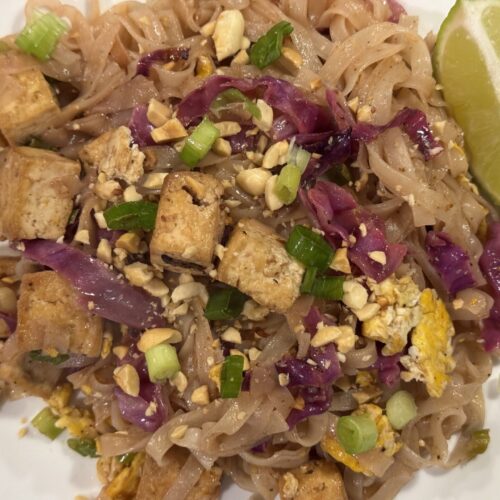
I often speak reminiscently of my college years. From 2008 through 2012 and a little beyond, it was a time of great exploration and experimentation, and when it came to the culinary world I had very few misses. Thai cuisine, specifically pad thai, was perhaps one of the greatest of all finds.
Pad Thai holds a special place in my heart—not just for its flavors but for the memories it evokes. I can still picture Thai Taste, the little corner spot on North Illinois Avenue and Walnut Street in Carbondale, where I first stumbled upon this dish.
You can see here, in this first picture from January 28th, 2013, a dimly lit view of their “world famous” Pad Thai, one of very few of many visits where I took any photos.
Walking in for the first time, I was completely out of my depth, staring at a menu filled with unfamiliar dishes and flavors. The server pointed me toward Pad Thai, and I decided to take a chance. What arrived at my table was a dish unlike anything I’d ever tasted—both surprising and comforting at the same time.

The Peculiar Appeal of Pad Thai
I’ve come to believe that what makes Pad Thai so captivating is the way it brings together a diverse and eclectic mix of ingredients into one harmonious dish.
The tender bite of rice noodles, the crispness of fresh green onions, the nutty crunch of peanuts, and the vibrant tang of lime all work together to create something far greater than the sum of its parts.
It’s a dish that feels effortless but is anything but random. Every element, from the textures to the interplay of sweet, sour, salty, and umami, is perfectly calibrated.
Veganizing Pad Thai
When creating this vegan version, I’ve leaned into using vegan fish sauce, as much as I prefer to avoid anything approaching proprietary. It offers that deep, salty, umami quality that traditional fish sauce provides, without compromising on plant-based principles. For me, it’s what takes me back to those original tastes.

For those who don’t have a flavor memory they’re trying to bring back, or those who may not have vegan fish sauce readily available, it’s possible to craft a very good alternative from scratch.
In short, a blend of tamari or soy sauce, lime juice, tamarind concentrate, and a touch of garlic and shallots creates a similar balance of bold and tangy flavors. A pinch of seaweed or miso paste can also add a hint of that briny depth. Very soon, I’ll be adding a recipe in here that uses readily available ingredients that arrives close to the same thing, based on the different taste principles.
In addition to the ubiquitous sauce, tofu takes center stage as the protein of choice—both a nod to Thai culinary tradition and a natural fit for plant-based adaptations. For the egg, a vegan substitute like Just Egg works beautifully, or you can skip it entirely for a simpler preparation. These adaptations don’t just replace traditional ingredients; they highlight how plant-based alternatives can elevate the dish in their own right.
Crafting this vegan Pad Thai has been a journey of rediscovering one of my favorite dishes in a way that aligns with my values and the ingredients I love to work with. It’s a vibrant, balanced plate that captures the essence of Pad Thai while offering an accessible, plant-based twist.
I hope that you enjoy just as much as I did then, and still do!

Vegan Pad Thai
Ingredients
- 2 tbsp avocado oil or other suitable high-heat oil
- 1 block extra firm tofu
- ¼ cup vegan fish sauce
- 4 tbsp tamarind concentrate
- 2 stalks green onions rinsed and finely chopped, with the first inch of each end discarded
- ¼ cup peanuts chopped
- ¼ head red cabbage chopped into 2-inch long pieces